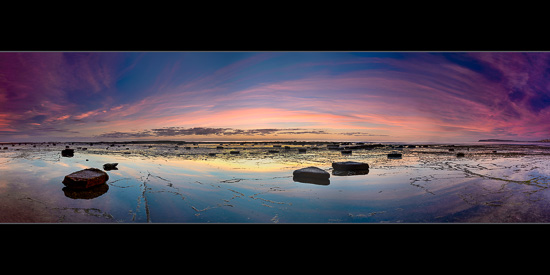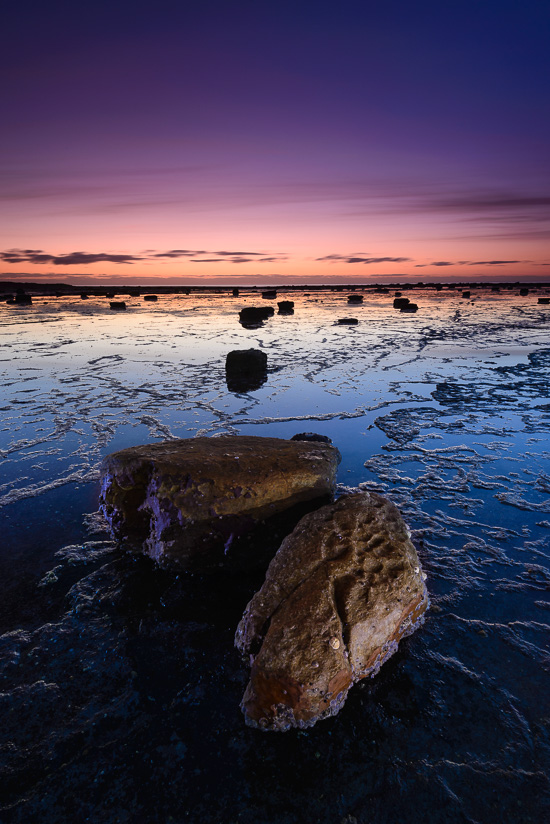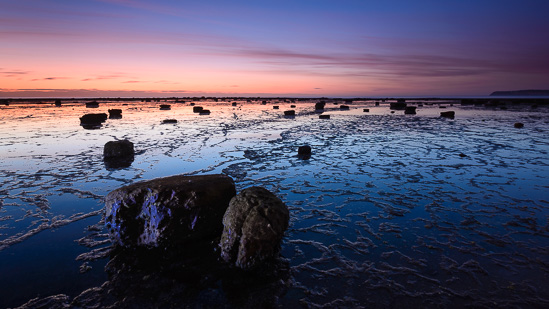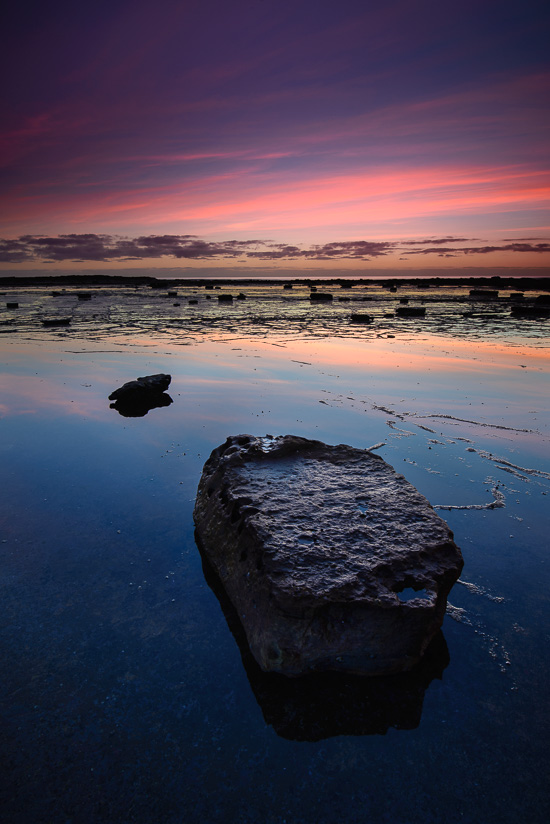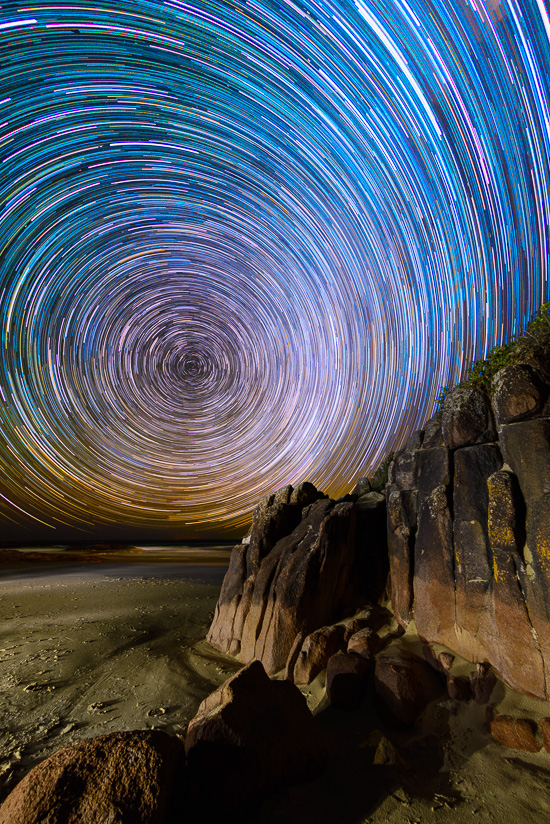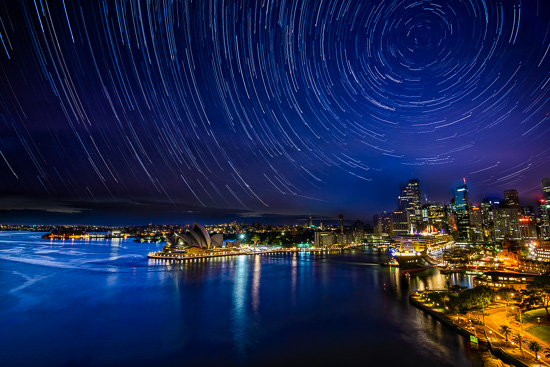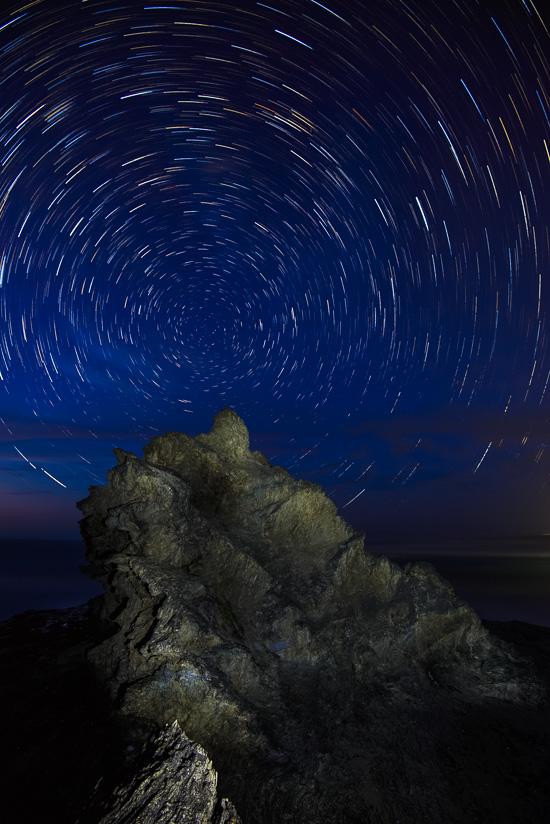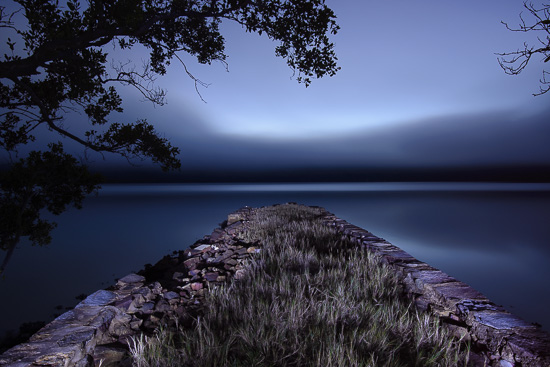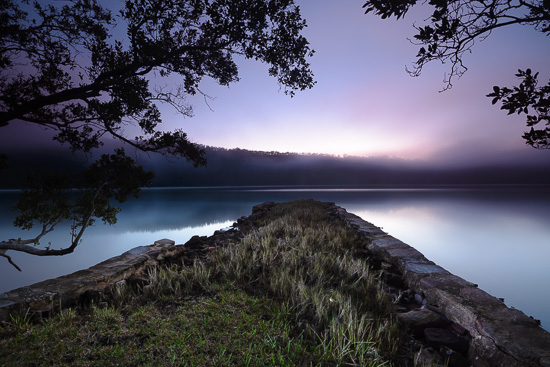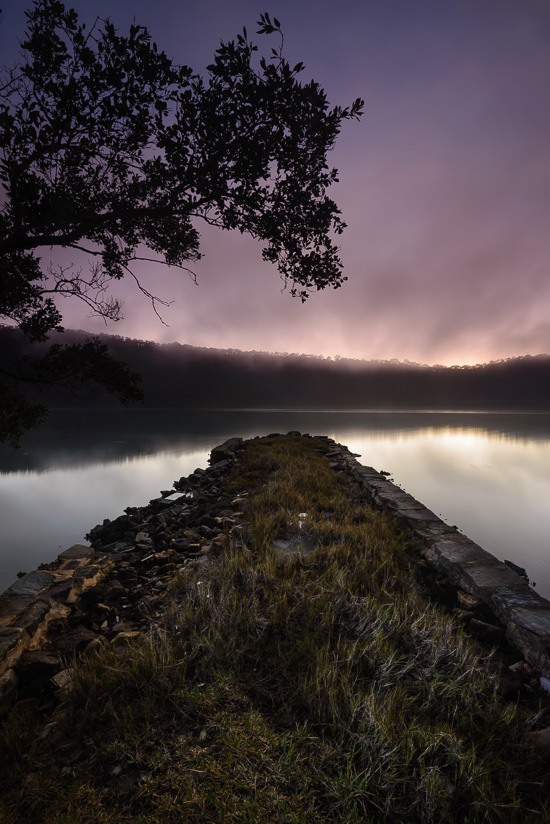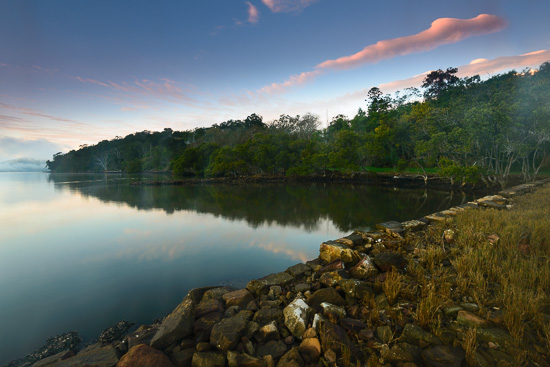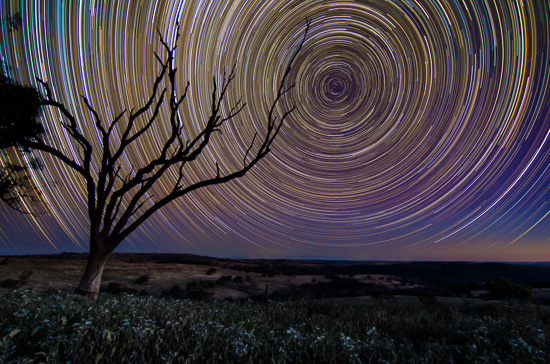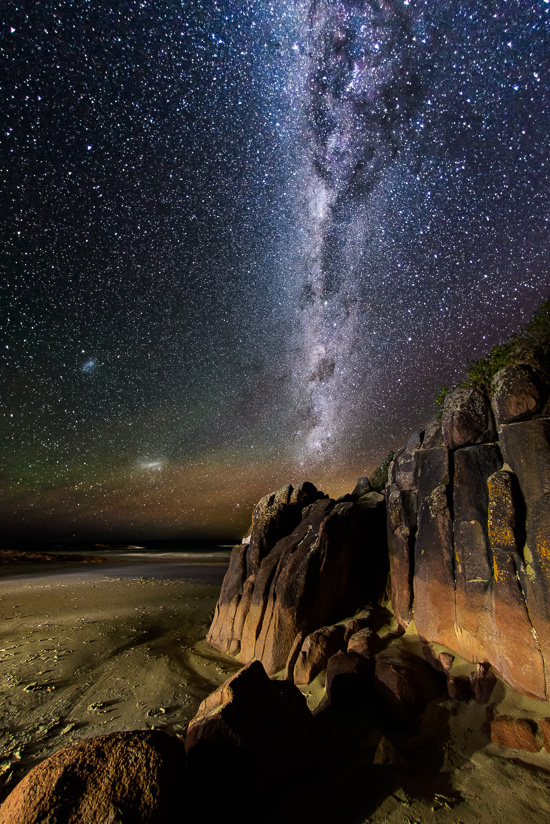Archive for November, 2014
Reef Panorama…
by Rodney Campbell on Nov.29, 2014, under Life, Photography
As I was already setup for a vertical composition I then decided to put together some frames for a stitched reef panorama. Being lazy yet again I just zoomed the lens I had on at the time (the 16-35/4) as much as I could (35mm) rather than changing lenses to the 24-70.
Note: These photographs (especially the wider shots) look much better when larger – so click any of the images below to see larger versions in an inline overlay slideshow gallery viewer.
This first one was a bit of a test – and it was a little funky because I still had the polariser on and things go awry the closer we get to pointing 90° to the rising sun – i.e. the left and right of this panorama. Still I liked what the clouds and the reflection were doing so persisted with the panorama.
Glass Eye
This one is a full 360° panorama – with the polariser now removed – the result of stitching 18 frames. I’ve actually cropped the left edge slightly for compositional reasons – looks sort of like a face with two eyes and a nose to me…
On the left we have the Long Reef headland (with a nice golf course up on the top) with the rocks on the reef scattered all around us and Jason Baker is over on the right taking a long exposure. I had to adjust the exposure a little on the way around with this one – because some of the frames are pointing towards where the sun was rising and some away from it and the light levels were changing rapidly in the few minutes it took to take all the frames.
Reflected Eyes
The Rocks of Long Reef…
by Rodney Campbell on Nov.27, 2014, under Life, Photography
I joined fellow Sydney photographer Jason Baker and a visiting friend from Melbourne Lachlan Downing for an impromptu sunrise session at Long Reef on Sydney’s Northern Beaches.
This location is usually a photographers delight with a very large reef area surrounding the point of land jutting out into the ocean. There’s usually something to shoot here no matter the tide. Strewn across the large shallow reef area are hundreds, perhaps thousands of interesting rocks of varied shapes and sizes.
Note: These photographs (especially the wider shots) look much better when larger – so click any of the images below to see larger versions in an inline overlay slideshow gallery viewer.
Two
This image was taken just before 5:25AM (25 minutes before sunrise). I’ve switched to my favoured vertical composition and swivelled around the same two rocks but this time facing more to the east and towards where the sun will rise in 25 minutes. I’ve light painted my foreground rocks with some selective low zoomed torch but stronger this time to really pop those rocks from their surrounds.
The image below was the first of the morning session and taken just five minutes before the previous image. It gives you a good idea of what the reef looks like with a low to mid rising tide. Here we are looking south east with the sun over the horizon to the left and I’ve used a touch of low light painting on my chosen foreground rocks.
Crackled Perspectives
This is one of those times where the slight colour cast when stacking the Format Hitech Reverse Grad with the Lee Grad works to my favour.
As it approaches sunrise it gets much brighter quite quickly and we loose the natural long exposures. I’ve found myself a new rock – one in a larger but very shallow still pool of water
Boulder on Ice
As I was already setup for a vertical composition I then decided to put together some frames for a stitched panorama.
Shooting Stars Technique…
by Rodney Campbell on Nov.24, 2014, under Life, Photography
A couple of days ago I started this series by covering the gear you might need for shooting stars (the Milky Way or star trails). In this post I’m going to cover some of the in the field technique and settings to use to take the images.
So What are some of the suggested techniques and camera settings for Shooting Stars:
Dark Skies
First of all you need to find a location to shoot at. For most people finding a location with dark skies is probably the hardest thing to find. The vast majority of people live in populated areas and the light pollution from our cities makes it much more difficult to get good images of the milky way.
Whilst it is possible to take passable images of the Milky Way and even better star trail images in light polluted areas (if taken with some care and planning), your best results will occur if you can go out into a remote location far away from cities.
Galactic Whirlpool
NIKON D600 + 15.0 mm f/2.8 @ 15 mm, 41 sec at f/2.8, ISO 1250 x 127 Frames
Once you have a selected location you want to optimise the time and conditions that you visit.
For both stars (Milky Way) and star trails there are a few optimum environmental conditions:
– minimal light pollution (lights from the ground shining up into the sky washing out all but the brightest stars – cities are bad)
– clear skies (clouds obscure the stars)
– minimal moon (anything above about a quarter moon will both light the sky and obscure the stars (and overexpose the frame if it includes the moon)). Ideally shoot during the new moon but sometime between the last quarter and first quarter of the moon phases. This rule isn’t absolute but the closer to the new moon, the more time you will have with dark, moonless skies.
There are a number of resources to assist with finding locations with dark (less light polluted) skies including The World Atlas of Artificial Night Sky Brightness, the Light Pollution Map and Dark Sky Finder.
Composition and Focus
I’d suggest working out your basic composition first. Attach your widest fastest lens and start at the wide angle end (if using a zoom lens). Treat this like a landscape composition (because it is) – you’ll want to create a balanced layered composition with a good foreground element to go with your background.
One of the keys to good astro photographs is to not just include the sky but also some frame of reference to balance the composition and juxtapose against the enormity of the universe.
Now is also a good time to get out that star location app and work out where the stars will be. If you’re in a dark enough location you should be able to see the Milky Way with your naked eye – if you can’t then you’re probably going to be in trouble (unless you’re only planning on shooting star trails).
If you’re shooting a star trails you’ll want to know where the galactic rotation point (celestial pole) will be as the stars will rotate around this point over time. Even if you’re not just planning to do star trails and wish to take a static single image of the stars or Milky Way this will be useful information. This is because the stars rotate (and thus streak/trail) much more when pointing your camera toward the celestial equator line (away from the centre of rotation) than when pointed at the pole (centre) and this can influence your shutter speed calculations.
I like to focus beforehand and then just lock my focus to manual for the shoot. If I’ve included some strong foreground interest I’ll usually focus on that or just past that (or just focus at roughly the hyperfocal distance). For this I usually just use a strong torch to achieve auto focus and then switch to manual.
If I’m taking separate foreground shots (e.g. during twilight or via light painting) which I plan to blend later in post processing then I may adjust the focus (and aperture) separately between those foreground images and shooting the stars. In this case I’d shoot the foreground as normal with a closer hyperfocal focus and then ideally focus at infinity (or something very very far away) for just the static stars.
If I’m shooting star trails I actually like the stars to be a little out of focus since I’m creating an overall blurred line effect, so I’ll just use the foreground focus for both the foreground shots as well as the star trails shots.
I’d suggest taking test shots and zoom the LCD all the way in to check the focus of both your foreground element(s) and the stars.
Camera Settings
What follows is not a hard and fast rule but rather some good starting point settings.
Based on some test exposures you may find you have to adjust your exposure parameters depending on things like the level of light pollution, moonlight and other ambient light; your camera and lens capabilities and so on.
– RAW – I’d suggest shooting in RAW mode which captures more data and allows you more flexibility in post processing.
– Manual – set your camera’s exposure mode to (M)anual (where you can manually adjust both Aperture and Shutter Speed).
– White Balance – I suggest just using AutoWB. If you’re shooting star trails you can sync up all the images to a selected white balance later in post processing (if you shoot in RAW).
– Auto ISO – if your camera has an Auto ISO capability – turn this off and set the ISO manually.
– Long Exposure Noise Reduction – if you’re shooting star trails definitely turn this off (because it takes a dark frame for every – shot equal to the length of the shot just taken and will result in lots of gaps in your trails). If you are shooting single starfield images (Milky Way) then you may want to turn this on for cleaner images at higher ISO’s (personally I don’t bother and use Lightroom’s excellent noise reduction options in post processing if required).
– Aperture – set an aperture at or near wide open (smallest f/number). This depends somewhat on the optical characteristics of your lens – how sharp it is wide open, what level of coma it has, and so on.
Exposure
Aperture
Above we mentioned that we would shoot at or near wide open on the lens (f/2.8 or better ideally). Now we will look at the two other parameters which go into the exposure triangle – shutter speed and ISO.
It’s the shutter speed and ISO which are the predominant differences between when shooting single starfield (e.g. Milky Way) images versus taking the repeated frames for a star trails image. I’ll cover both and the differences below.
Shutter Speed
For single starfield (Milky Way) images you ideally want the stars to appear is single pinpoints of light in the sky and not to trail (appear as lines).
The shutter speed is calculated based on what is often called the “500 Rule”. This in turn is based on the focal length of your lens and the physical size of the sensor in your camera. Longer focal lengths and smaller sensors require shorter shutter speeds to prevent the stars from trailing/streaking.
The “500 Rule” works like this – divide 500 by the full frame equivalent focal length of your lens and that represents the maximum shutter speed you should use to avoid having trailing stars in your images and instead having point stars.
Some examples below:
– when using a 14mm lens on a full frame camera this leads to 500/14 = 35.7 seconds
– with a 35mm lens I’d have to stay under 500/35 = 14.3 seconds
– when using a 10mm lens on a 1.5x crop factor (APS-C) camera it’s 500/(10*1.5) = 33.3 seconds
– a 24mm lens on the same camera is 500/(24*1.5) = 13.9 seconds
– using a 12mm lens on a 2x crop factor (micro 4/3rds) camera it’s 500/(12*2) = 20.8 seconds
As mentioned above this is somewhat dependant on whether you are shooting towards or away from the celestial pole so you may need to adjust this after taking a test image and zooming into the frame to check the stars (especially near the edges of the frame.
If you are shooting star trails then the above is less important. You now actually want trailing stars so shooting for longer than the 500 rule is actually good.
Generally for star trails something in the range of 30 to 120 seconds is a likely candidate. However the shutter controls the ambient exposure – so be careful not to overexpose the sky or any light pollution. You may find in heavily light polluted areas (like shooting right in the city) you need to use relatively short exposures (much less than the 500 rule) so as to not completely overexpose the sky.
With star trails the tradeoff is between total number of images taken for a set time period (and how many you end up having to store, process and stack in software) versus how bright the background sky becomes. If you are shooting is really really dark skies you can afford to shoot longer shutter lengths and have less overall images to deal with whilst still having an ambient dark sky, conversely in light polluted areas you need to take many more shorter exposures.
ISO
The ISO is calculated based on your aperture and shutter speed but it’s a little dependent on the noise performance of your camera.
If you are shooting single starfield (Milky Way) images in dark skies you would probably start with an ISO somewhere in the range of 3200 to 6400 (assumes an aperture of f/2.8 to f/4). If you are shooting with a wider aperture you can adjust the ISO down accordingly.
If you are shooting star trails you are likely shooting with a shutter speed longer than the 500 rule anyway but I tend to use ISO’s from 1600 and below (sometimes in not particularly dark, light polluted skies I have to use ISO’s as low as 400 with an f/4 lens).
QM2 Under the Stars
NIKON D600 + 16.0-35.0 mm f/4.0 @ 17 mm, 25 sec at f/4, ISO 400 x 230 frames stacked for star trails blended with a 30 second @ f/11 and ISO 400 twilight exposure
The tradeoff here is sensor noise versus capturing the fainter stars (vs light pollution). Here you have to be careful not to overexpose your stars – stars actually have different colours so if they are all white and not coloured you know you’ve probably overexposed.
Time to Shoot
So now its time to shoot…
– lock your camera down on a tripod (I sometimes use a sand bag or my camera bag hanging from the centre column hook to weigh it down)
– take a suitable twilight or light painted foreground image if you are going to use this (this will form the basis of the non sky components of your final image) using normal landscape settings (aperture stopped down, low ISO, grad filters, etc)
– do not move the camera and do not change focus
– change to star capturing settings: Aperture (at or near wide open), Shutter (500 rule or star trails settings), ISO
– put the camera in bulb mode
– if taking single starfield (Milky Way) images setup the remote trigger to take images at your chosen shutter speed (500 rule)
If taking star trails:
– setup the intervalometer to take the number of continuous frames you need – you need to setup the shutter length (e.g. 60 second exposures), the interval gap between shots (the shortest you can set this to (e.g. 1 second interval is common but my remote allows 0.1 second intervals) and finally the number of shots to take (sometimes this is limited to 99 but mine has a setting for infinite)
– ensure your camera is set to continuous shooting mode
– start the sequence once the sky is completely dark
– allow the camera to take as many images as you need – depending on how dark the skies are and whether you are shooting towards or away from the celestial pole you may choose anywhere from 30 minutes to many many hours depending on the length and density of the star trails you’d like in your final image
The Promise
Milson Island Sunrise…
by Rodney Campbell on Nov.21, 2014, under Life, Photography
I was once more a parent helper for one of my daughters stage 3 (years 5 & 6) school camps, visiting the lovely NSW government Sport and Recreation facilities on Milson Island.
The island is located on the Hawkesbury River north of Sydney and has had a very chequered history. It was first settled over 100 years ago and has been used as a farm, a mental hospital, a jail, and now a sports and recreation centre.
I’d been to Milson Island before for my eldest daughters school camp four years previously and it’s always fun joining in on the activities like Archery, High Ropes and so on.
This time however I was keen to do a sunrise photo session whilst on the island. It had been raining almost constantly in the weeks leading up to the camp so I was a little worried about the conditions.
Note: These photographs (especially the wider shots) look much better when larger – so click any of the images below to see larger versions in an inline overlay slideshow gallery viewer.
River Mystique
I’d spied this location during the first day as it was very close to where the Kayaking is done, so I rece’d the area, checked out TPE and worked out roughly what I might do. This old stone jetty, crumbling and abandoned, overgrown with grass and sticking out from Milson Island into the waters of the Hawkesbury River looked a prime candidate with it pointing eastwards towards where the sun would rise behind the peninsula of land on the other side of the river.
I woke before 5AM and since I was up and had sort of talked myself into shooting sunrise here one morning, decided to get up and head down to the nice little old stone jetty. It was a cold and very misty/foggy morning when I got outside. We’d had great weather on the first day so it was a reasonable bet to get up early the next morning and head down to the Hawkesbury River (eastern) side of the island for sunrise. As it turns out this was a good call since it rained the next morning.
The first shot above is at 5:23AM – 40 minutes before sunrise – a three minute long exposure with some light painting of the foreground with a small zoomable torch and just the Formatt-Hitech 3 stop Reverse Grad to hold down the sky.
This is another before sunrise (5:37AM) – even though it was still almost 30 minutes to sunrise it had lightened significantly in the ten or so minutes since the first shot above
Jetty’s Dawn
The mist was very heavy this morning and it hung low over the water till well after sunrise. This shot a vertical composition down this old stone jetty just ten minutes after the shot above (5:47AM). It’s still before sunrise but it was getting very bright by this stage – even down at ISO 50 I could only get a 15 second exposure at f/11
Hawkesbury Mist
This last is a few minutes after sunrise at 6:06AM
Milsons Vapours
Gear Selection for Shooting Stars…
by Rodney Campbell on Nov.19, 2014, under Life, Photography
More than two years ago I took my very first star trails image (shown here) and wrote a post on shooting star trails. I’ve learnt a lot since then and as I’ve been shooting stars (Milky Way) and star trails recently plus there has been some interest in learning strategies and technique for this, I thought I’d put together a series of more detailed posts on the topic.
This first post will go through some of the gear selection and planning for shooting stars. In a follow up post I’ll cover the in the field technique and settings to use to take the images.
So what Gear do you need to produce great shots of Stars (The Milky Way) or Star Trails:
– a camera
– a fast wide angle lens
– a sturdy tripod
– a remote cable release
– enough battery power
– a large enough memory card to hold all the images
– a headlamp/torch
– optionally a smartphone star location app and photo planning app
– software to stack the resulting images (Adobe Photoshop, Startrails.de, DeepSkyStacker, StarStax, etc)
Reach for the Stars
Nikon D7000 + Tokina 12-24mm f/4.0 Lens @ 12 mm
Twilight Image: 58 seconds at f/11, ISO 100
Star Trails Images: 210 x 60 second exposures (3.5 hours) at f/4.0, ISO 1250
Camera
An expensive pro level camera is not required to take good Milky Way or star trails images. Any camera with full manual controls and a relatively decent ISO performance (can shoot up to ISO 1600) is perfectly adequate for star trails. For static star (Milky Way) images you may want a higher ISO performance (ISO 3200/6400). You will also need the ability to specify manual settings and ideally with the ability to select a bulb mode for long exposures.
I’d recommend for most people this would cover most D-SLR’s (full frame or APS-C (crop)) or Mirrorless systems (full frame, APS-C or (micro) 4/3rds)
Fast Wide Lens
A fast wide angle lens is probably the most important piece of gear for shooting stars.
The two important parameters for a lens to use is that:
1) It has a short focal length (wide angle of view)
I recommend a focal length of around 35mm or less on full-frame cameras, 24mm or less on APS-C cameras and 16mm or less on Micro 4/3 cameras. You can definitely go much wider than this starting point – I often shoot down at around 14/15/16/20mm on a full-frame camera.
There are two reasons for this – wider angles allow you to use longer shutter speeds which allow you to gather more light (see the 500 rule in the next post). Secondly the sky and universe is a pretty broad expanse so a wide field of view from the lens allows you to capture more of it along with an interesting foreground. You’ll notice this even more when taking star trails.
2) It has a wide maximum aperture (lower f/number’s are better)
The darker the conditions the lower the f/number you will be able to use and you will be able to capture the fainter stars. It also allows you to shoot at a lower ISO whilst maintaining the same “exposure” for less noisy images and a higher signal to noise ratio.
At a minimum a lens which can shoot acceptable images at f/4 would be required and anything faster (e.g. f/3.5, f/2.8, f/2, f/1.8 and f/1.4) is progressively much better.
Some suggested lenses for astro photography include:
Full-Frame: Samyang 14mm f/2.8, Sigma 15mm f/2.8 Fisheye, Nikon 20mm f/1.8, Samyang 24mm f/1.4, Sigma 35mm f/1.4 Art, Nikon 14-24mm f/2.8
APS-C: Samyang 10mm f/2.8, Samyang 16mm f/2 and Tokina 11-16mm f/2.8, Sigma 18-35mm f/1.8
You may want to keep the lens warm and protected to prevent dew formation (lens hood and I have used some woollen socks wrapped around the lens) – this is only a requirement if the ambient temperature and humidity is such that dew might form.
If you’re interested in much more detail about this topic with detailed information on a much larger set of available lenses then please check out Ian Norman’s excellent How to Pick a Lens for Milky Way Photography.
Tripod
Your exposures are going to be long (at least many seconds and perhaps many hours for star trails) so you want your camera to remain perfectly stable for the entire time.
Remote Cable Release/Intervalometer
A remote cable release will allow you to take shots without having to touch/bump or move your camera.
Ideally (and for star trails it’s essentially a requirement) you want one with an intervalometer function – some cameras have this function built in but personally I still like to drive this externally – that way I can make changes to the program and settings without touching the camera itself.
These can be bought extremely cheaply (e.g. on eBay) for around $20 for a wired model and from $40-$100 for a wireless model.
Power/Batteries
Both for your camera and also your intervalometer. If you are taking star trails these will be running constantly perhaps for many hours and will drain power quickly.
A single large battery, spare batteries or battery grip to last the desired number of frames (remember also that batteries last less in the cold).
If you want to conserve power also manually turn off your LCD/image review.
Headlamp/Torch
It will be dark so you won’t be able to see, and you may also find it useful to create some lit foreground images to blend with later in post production.
Star Location & Photo Planning Apps
A Star Location App will allow you to find where the Milky Way is and will be (if you can’t already see it with the naked eye) and for star trails will also allow you to find the celestial pole).
I knew if I wanted to have the trails appear as a circular pattern around a central point in the sky I’d need to point roughly south (actually they spin around the Southern Celestial Pole (in the southern hemisphere – for folks in the northern hemisphere you want the northern pole star)).
I use an IOS app called SkySafari or StarTracker so I can locate where Sigma Octantis (the closest thing to the southern pole star) is going to be in the sky.
Two excellent photo planning applications are The Photographer’s Ephemeris (TPE) for IOS & Android and PhotoPills for IOS, which will allow you to plan for moonrise, moonset, the phase of the moon, sunrise and sunset.
Galactic Chimney
In the next part I’ll cover some of the in the field technique and settings to use to take the images.
